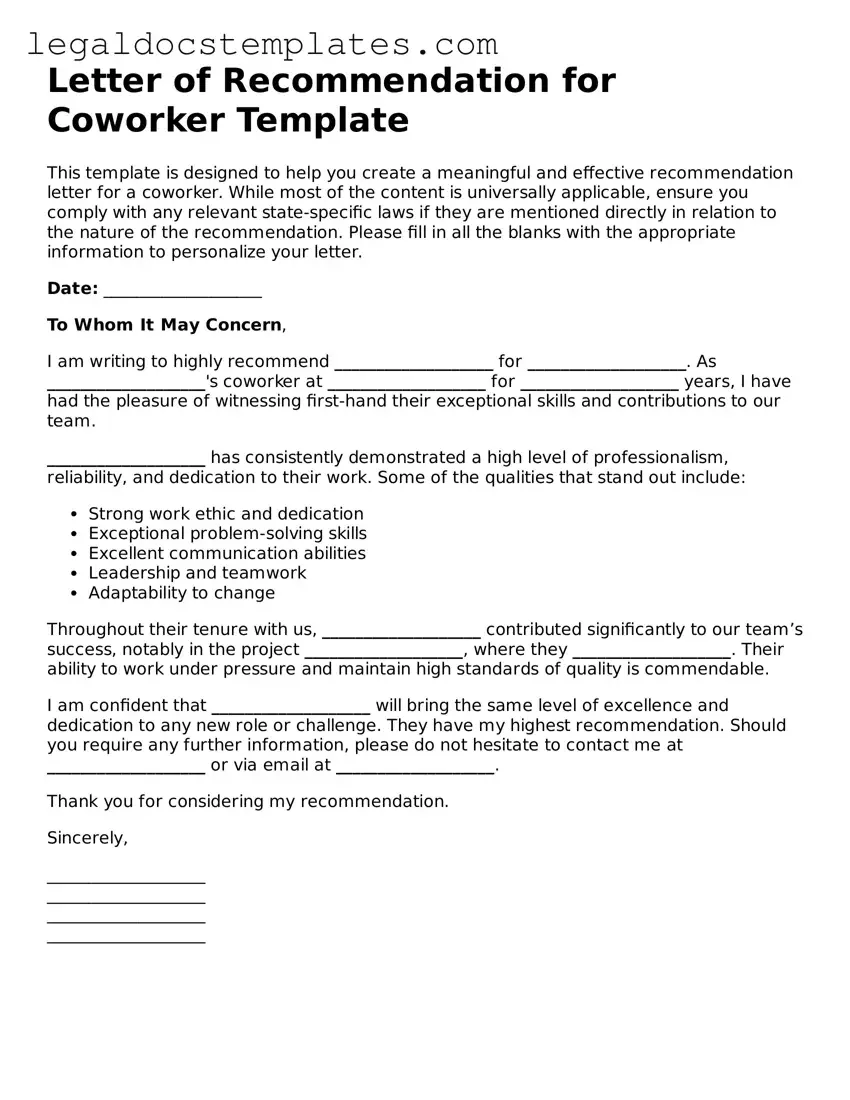A Letter of Reference for Employment shares similarities with a Letter of Recommendation for a Coworker in that both serve to endorse the candidate's skills, experience, and character to a prospective employer. Both documents provide a firsthand account of the candidate's qualifications from someone who has directly worked with or supervised them, detailing their contributions, work ethic, and professional demeanor. However, the Letter of Reference for Employment is more formally aligned with the prospective job's requirements, emphasizing the candidate's suitability for a specific role.
Similarly, a Character Reference Letter echoes the intent of a Letter of Recommendation for a Coworker by focusing on the personal attributes and virtues of the individual in question. Though this letter might be less about professional skills and more about personal character traits such as integrity, reliability, and morality, it still provides valuable insight into the individual’s demeanor and social comportment, which are important in any professional setting. This letter is often used in situations requiring a testament to character, such as court proceedings, housing applications, and more.
The Academic Recommendation Letter, like the coworker recommendation, aims to boost the subject's standing in the eyes of a reviewer. Whereas the coworker recommendation is designed for a professional context, the Academic Recommendation Letter targets educational pursuits, emphasizing the candidate's intellectual capabilities, academic achievements, and potential for success in a higher education setting. Both documents draw from the author's personal experience with the individual to advocate for their application, whether to a job or an academic program.
Performance Reviews conducted within a company bear resemblance to a Letter of Recommendation for a Coworker because they both assess an individual’s contributions and achievements. However, Performance Reviews are typically more structured, focusing on meeting specific job performance criteria and goals within the organization. They are used internally for decisions on promotions, raises, and professional development, unlike the recommendation letter, which is designed for external audiences.
An Endorsement Letter, often used within professional networks, shares its purpose with the Letter of Recommendation for a Coworker by signaling support for someone’s skills and qualifications. This form of letter, however, is usually shorter and may contain a broader endorsement without delving into specifics. It’s frequently used in contexts where the receiver values the endorsement of the author, such as for board positions, special projects, or speaking engagements.
A Professional Bio, while not a letter, complements a Letter of Recommendation by presenting a narrative of the individual’s professional journey, achievements, skills, and qualifications. The bio provides a self-authored profile that highlights accomplishments in a format that can be used on websites, portfolios, or conference programs. In contrast, the recommendation letter offers an external perspective on these qualities, validating the claims made in the professional bio through another’s experience and observations.
Lastly, a Networking Letter, designed to seek advice, job leads, or introductions, parallels a Letter of Recommendation for a Coworker by leveraging professional relationships. While the Networking Letter is initiated by the individual seeking opportunities, expressing their own qualifications and aspirations, a Recommendation Letter is a supportive document provided by a colleague or supervisor, affirming the individual’s suitability and readiness for new opportunities. Both are strategic tools in career advancement, emphasizing the value of professional networks.
